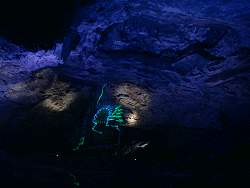Son et Lumière
Sound and Light Show

Son et Lumière (lit. "sound and light") is a French thing. Nevertheless, we have seen it everywhere, but in France is the home of those light shows, and actually almost any show cave tour in France has one. Those shows are not restricted to show caves, but they work very well in caves.
This technique uses coloured lamps, which can not only be switched on and off, but it is possible to make them brighter and darker. The changing lights are integrating buildings or probably cliff faces into the show. During the night the pyramids or the old château at the Loire become the canvas on which coloured light is projected, to the choreography of the music. Special lighting effects synchronized with recorded or live narration and music to dramatize the history of the place. The technological requirements are rather low, you just need some lamps which can be turned on and off and a sound system for the narration and the music. Of course, it works better if you have a lot of lamps, are able to dim them, and have a good PA.
The invention of the concept is credited to Paul Robert-Houdin, who was the curator of the Château de Chambord in France. He actually made the world’s first son et lumière in 1952. Another legendary son et lumière was established in the early 1960s at the site of the Great Pyramid of Giza in Egypt. It is made until today, and made th concept known to millions of visitors.
Cave have a canvas, white walls and speleothems. They have a light system, and additional lamps are rather easily installed. And it’s possible to install a sound system, which works outdoors, underground. So there is actually no difficulty in making such a show underground, and with a little automation its possible to make it automatic, the guide presses a butt, the show runs for five minutes, and the tour continues. Its important that the show is not too long, the visitors have to stand in the damp and cool cave without moving. Typically, it is as long as the piece of music which is used, so probably 3 to 5 minutes.
Sometme sthe show tells a story of the history of the cave, or a legend which is told by the cave. There are also shows which play a piece of music which represents the morning while the dawn is simulated by lights. Or its just music which emphasises or dramatises the special shapes of the cave. Classical music is often used, but also electronic pop. Pink Floyd, Mike Oldfield, or Jean-Michel Jarre come to mind. More modern shows use lasers, fog, strobe effects and animation. The really good ones use the shapes of the wall being projected onto and incorporate them into the story.
Although most people like them, you also have to be aware that they have some side effects. First of all, there is the expense of electronics, cables and lamps that are manufactured and installed in a Natural Monument. Over time, they release toxic substances into the cave. The power consumption for a 5-minute show is probably as high as for the whole rest of the tour, well worth considering in times of energy crisis and climate change. But the real problem is the strain on the cave fauna, and we are not talking about the bats, but the troglobionts of the cave. Nowadays, cave conservation has learned not to use concrete paths anymore, tarmac paths are removed expensively because of the released hydrocarbons, light systems are upgraded to save electricity and reduce waste heat. But bombarding the cave fauna, which is used to darkness and silence, with noise and light is suddenly okay, just because the show is funny? Apparently, everything works better with music, even undermining nature conservation. And this applies to artificial cavities just as it does to natural cavities.
 Search DuckDuckGo for "Son et Lumière"
Search DuckDuckGo for "Son et Lumière" Son et lumière (show) - Wikipedia (visited: 05-AUG-2021)
Son et lumière (show) - Wikipedia (visited: 05-AUG-2021)
 Index
Index Topics
Topics Hierarchical
Hierarchical Countries
Countries Maps
Maps